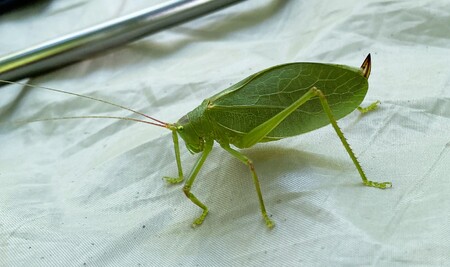
Good Natured: Katydids
Among insect folk tales one story stands out. Although the details vary, the ending (or is it the punchline?) is always the same and is repeated over and over, especially at this time of year.
The gist is that a newlywed couple was found dead, and their deaths were no accident. While no one was ever charged, the townspeople held strong opinions about one suspect in particular: the bride's sister Katy. The groom had courted first before falling for and marrying her sibling. Some folks felt Katy had motive, for she was jilted and jealous, yet others thought she was innocent. To this day, they say, Katy's role is debated by some of summer's most famous singing insects:
“Katy did."
“Katy didn't."
“Yes she did."
“No she didn't."
Such is the human interpretation of the call of the common true katydid, Pterophylla camellifolia, a song that features prominently in the soundtrack of warm summer nights.
It's funny though. As familiar as the raspy two- or three-note sound is, few people know what a katydid actually looks like. And it's no wonder. As denizens of the treetops, they're rarely seen. When they do come down—usually as the result of a strong wind or heavy rain—they're often mistaken for some sort of leaf-shaped grasshopper.
Their oblong shape and green color are leaf like indeed. So much so, in fact, that Johan Christian Fabricius, the Danish zoologist credited with naming the species, was compelled to point out its leafiness not once, but twice. The genus name Pterophylla translates to wing-leaf while camellifolia refers to the way the wings are shaped like camellia leaves.
In our area, common true katydids this year began their discussion around the third week of July. If you've heard them, you may have noticed that their cadence quickens on warm nights, and slows on cool ones. Regardless of temperature, the chatter will wage on for several more weeks, until the last of the bunch succumbs to autumn's hard frosts.
Although we tend to think of katydids and their cousins, the grasshoppers and crickets, as singers, they technically are fiddlers. To make their loud sounds, katydids draw the rough edge at the base of one forewing across the ridged edge of the other forewing in a scraper-and-file method of sound production known as stridulation.
The reason for all the noise is simple. It's mating season in KatydidLand! The strident, repetitive “katy-did, katy-didn't" calls are the sounds of males calling for females, who listen for and then select the mate they deem fittest.
A human female in a similar situation might cup her hand behind her ear to distinguish amongst the calls, but the female katydid adopts a different approach. She literally leans into her work, taking in sounds via tympana, or hearing organs, on her front legs, just below her knees.
Male katydids tune in too, paying attention to other males and alternating their calling frequency to create rowdy choruses of back-and-forth discourse. On warm nights, the volume can be considerable—as loud, or louder, than, say, a 2003 BMW F650CS, a motorcycle I've found to be a perfect vehicle for cruising around and listening to their performances.
You don't need to have ears on your knees, nor a motorcycle, to enjoy these summer songs. Just head out to an area with mature trees, right around dusk or even after dark. The rhythmic two- and three-note calls are impossible to miss.
What can be next to impossible though, for amateur enthusiasts like me, is identifying katydids by sight. Although today we've focused on the common true katydid, our area is home to some three dozen or so species in the Tettigoniidae, or Katydid, family. Several display the familial trait of looking like leaves, which complicates the process of trying to figure out who's who when looking at photographs.
However, only P. camellifolia has wings that form a rounded, hump-like cup over the back; in fact some references say this shape is why there is a CAMEL in the specific name. Common true katydids also have prominent veins on their wings, and two shallow grooves across the pronotum—that plate directly behind the head.
There's no denying, I'm a fan of katydids and their raucous ways. But I've learned over the years that not everyone shares this love. Occasionally here at Good Natured World Headquarters we receive calls—complaints, even—about loud sounds coming from park district trees late at night.
One caller in particular was quite vocal in expressing her displeasure, and performed a memorable recital in her voicemail objecting to the noise. It didn't take long to respond to her question of what animal was making the sound. Thanks to her apt description, the answer was simple: Katy did.
Pam Otto is the outreach ambassador for the St. Charles Park District. She can be reached at potto@stcparks.org.

